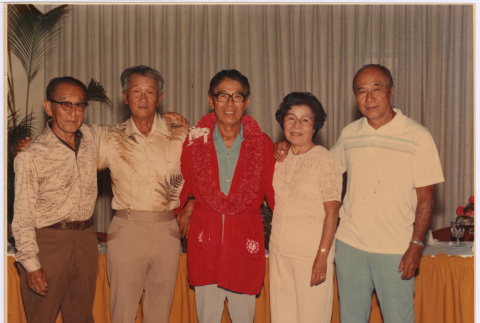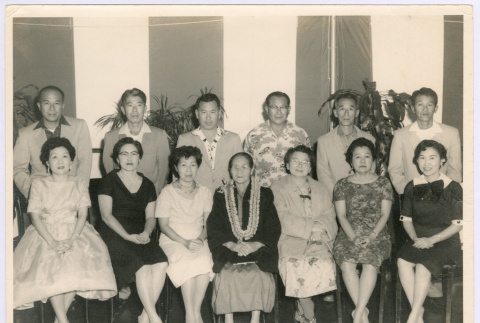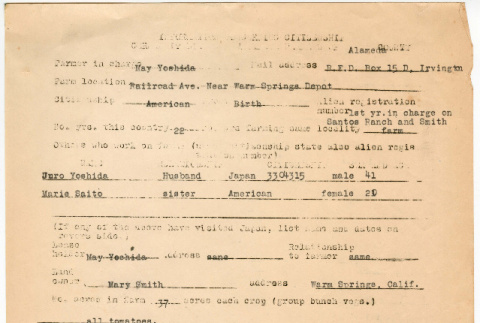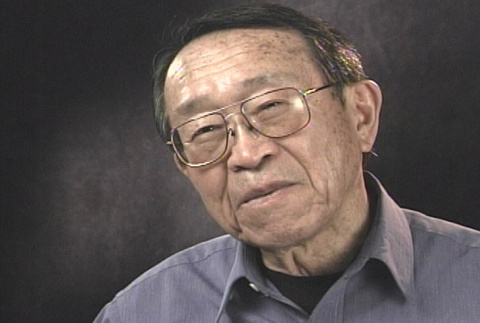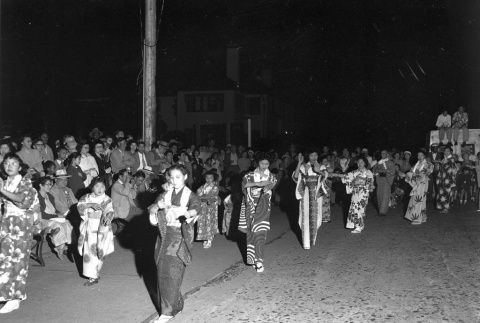67 items
67 items

img
Yoshida Siblings (ddr-densho-495-59)
Photograph of the Yoshida siblings together at Francis Tadashi's 65th birthday party. From left to right: Hitoshi Yoshida, Edward Sueo Yoshida, Francis Tadashi Yoshida, Alice Yachiyo (Yoshida) Nakamura and Jack Itosu Yoshida. Caption below photograph on album page is "Hitoshi Edward Dad Alice Jack / August 1975 65th birthday."

img
Yoshida family (ddr-densho-495-58)
Photograph of the Yoshida family with spouses. Back row left to right: Jack Itsuo Yoshida, Tadashi Francis Yoshida, Susumu Nakamura, Kazuto Albert Yoshida, Hitoshi Yoshida, and Edward Sueo Yoshida. Front row left to right: Patsy Yoshida, Nancy (Nagai) Yoshida, Alice Yachiyo (Yoshida) Nakamura, Saju (Ishimoto) Yoshida, Helen Masae (Takeshita) Yoshida, Doris Yoshida, and Ethel (Inouye) Yoshida. …
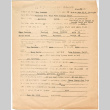
doc
Information concerning citizenship German, Italian and Japanese Farmers of Alameda County and associated documents for Yoshida family (ddr-densho-491-174)
Including "Kibei" survey, property report and family record
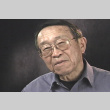
vh
George Yoshida Interview (ddr-densho-1000-132)
Nisei male. Born April 9, 1922, in Seattle, Washington. Parents immigrated from Japan in the early 1900s. Attended Bailey Gatzert Elementary School and Washington Middle School in Seattle before his family moved to East Los Angeles in 1936. Incarcerated in Poston Detention Camp #1, Arizona, in April 1942. While in camp, helped organize the "Music Makers," …
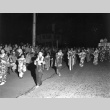
img
Obon Festival- Odori folk dance (ddr-one-1-215)
Black and white photographic negative of Obon dancers performing before a crowd. Obon dancers from left to right: Susanne Mineko (Sasaki) Myer, Susan Shizuko (Yoshida) Kurimoto, Mrs. Okayama, unidentified, Mary Yamaguchi, Jean (Tsujimura) Takashima, Atsuko "Alice" (Matsumoto) Ando, Noburo Takashima, Atsuko "Alice" Kida, remaining dancer unidentified. Obon is an annual event hosted by the Oregon Buddhist …

vh
George Yoshida Interview Segment 37 (ddr-densho-1000-132-37)
Decision to go back to school for teaching credentials; difficulty finding jobs because of racial background

vh
George Yoshida Interview Segment 44 (ddr-densho-1000-132-44)
Experiences in Japan: observing elementary art education, learning Japanese teaching techniques

vh
George Yoshida Interview Segment 32 (ddr-densho-1000-132-32)
Decision to leave camp for Chicago, Illinois; receiving help from a network of other Nisei for employment, housing

vh
George Yoshida Interview Segment 21 (ddr-densho-1000-132-21)
Hearing about Japanese Americans who were removed early; visiting friends in Santa Anita Assembly Center while still "free"

vh
George Yoshida Interview Segment 22 (ddr-densho-1000-132-22)
Preparing for mass removal: destroying Japanese cultural items, bringing popular music records; traveling to Poston concentration camp, Arizona

vh
George Yoshida Interview Segment 19 (ddr-densho-1000-132-19)
Awareness of Japan's political activities leading up to 1941

vh
George Yoshida Interview Segment 26 (ddr-densho-1000-132-26)
Witnessing medical reactions to incarceration while working at a camp hospital

vh
George Yoshida Interview Segment 1 (ddr-densho-1000-132-1)
Father's background: fluent in English at the time of immigration; "a bent for music"

vh
George Yoshida Interview Segment 40 (ddr-densho-1000-132-40)
Moving to El Cerrito, California; finding someone willing to sell a home to a Japanese American family

vh
George Yoshida Interview Segment 25 (ddr-densho-1000-132-25)
Working as an orderly at the camp hospital; observing a surgery

vh
George Yoshida Interview Segment 42 (ddr-densho-1000-132-42)
Teaching art to elementary school students; experimenting with different techniques and styles

vh
George Yoshida Interview Segment 18 (ddr-densho-1000-132-18)
Never considering pursuing a career in music

vh
George Yoshida Interview Segment 29 (ddr-densho-1000-132-29)
Helping to organize a dance band in camp, rehearsing evenings and weekends

vh
George Yoshida Interview Segment 39 (ddr-densho-1000-132-39)
Philosophy and experiences while teaching: "I think my special approach to educating these kids was a sense of humor"

vh
George Yoshida Interview Segment 33 (ddr-densho-1000-132-33)
Initial thoughts upon leaving camp for Chicago: "Free at last"

vh
George Yoshida Interview Segment 45 (ddr-densho-1000-132-45)
Cultural differences experienced while living in Japan

vh
George Yoshida Interview Segment 8 (ddr-densho-1000-132-8)
Meeting different ethnic groups: becoming "assimilated," absorbing the surrounding culture

vh
George Yoshida Interview Segment 49 (ddr-densho-1000-132-49)
Reflections on life: "I just feel very fulfilled"

vh
George Yoshida Interview Segment 6 (ddr-densho-1000-132-6)
Bailey Gatzert Elementary School: becoming more "Americanized," learning to play the harmonica in music class

vh
George Yoshida Interview Segment 27 (ddr-densho-1000-132-27)
Comparing incarceration experience with Native American situation
